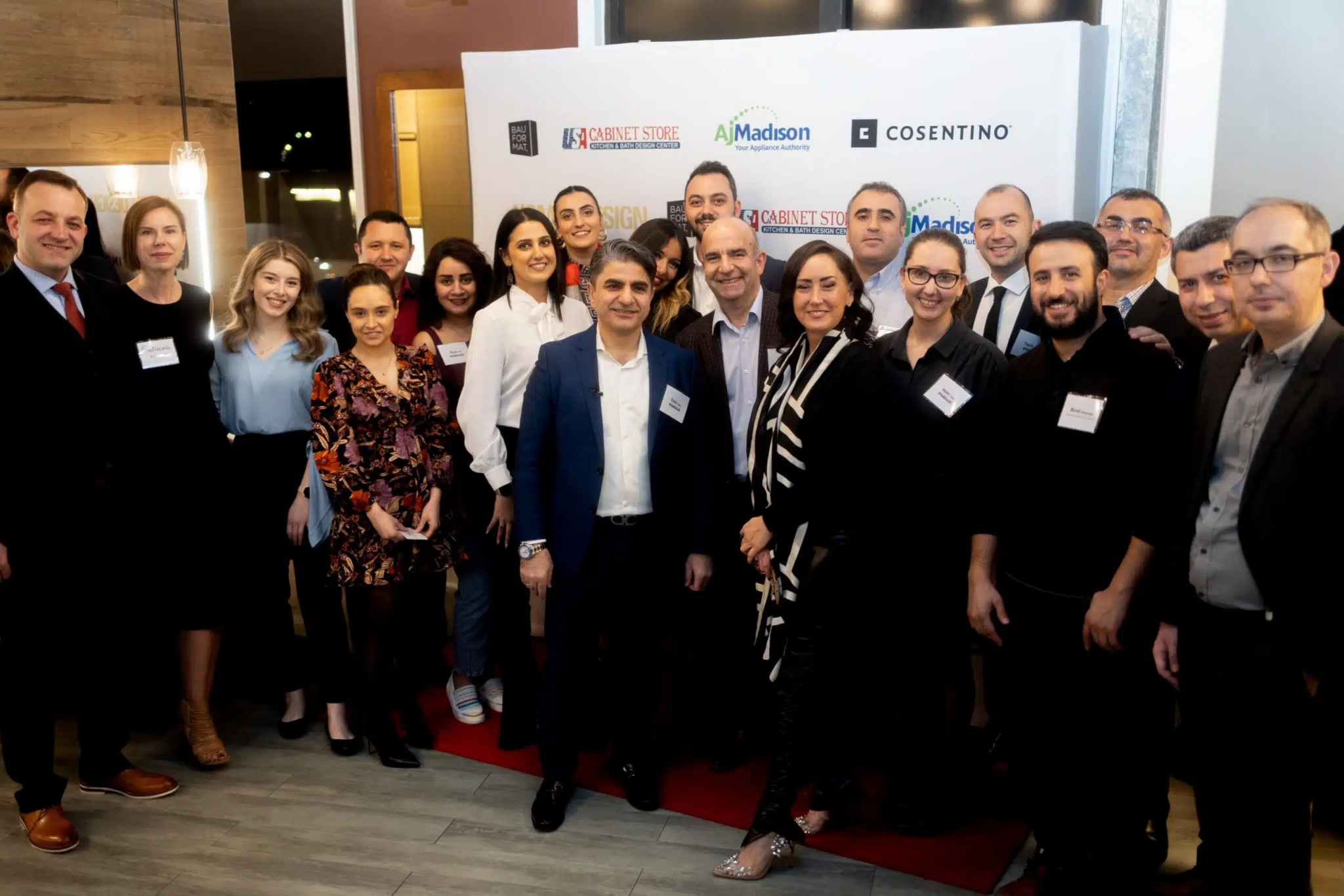Deciding on kitchen flooring ideas can be quite difficult. Some may claim that Luxury Vinyl Plank (LVP) is superior to parquet, while others may disagree and say that luxury vinyl plank is not the best. Among them, there will be a lot who insist that “solid wood is better than anything else.” It’s easy to get lost in all these options, but the important thing is to find the one that best suits your needs. Here, we are discussing the most popular kitchen floor tile ideas, their pros and cons, and their limitations.
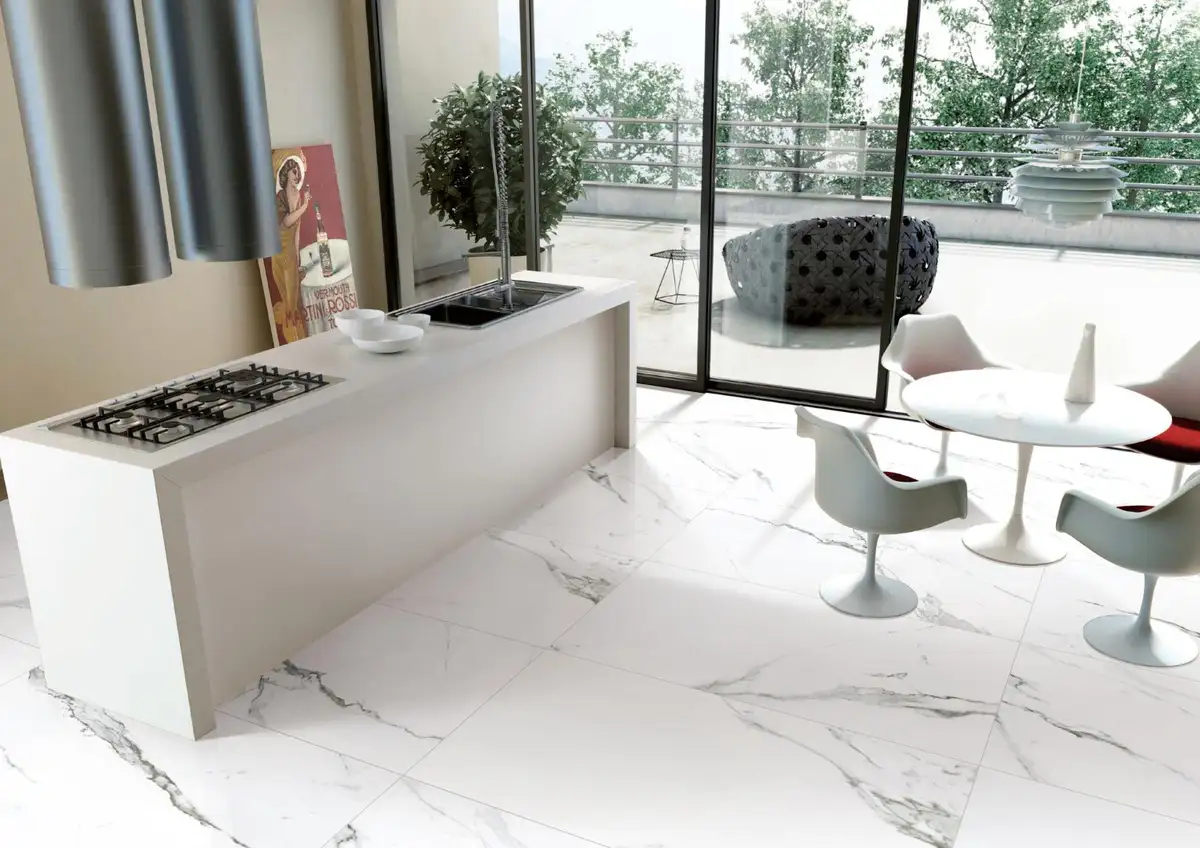
1. Porcelain Tile
Porcelain tiles are made by firing fine clay at high temperatures. Since they are denser and less porous than ceramic tiles, porcelain is durable and extra resistant to water. They are a savior for wet and active areas such as the kitchen. Available in wood, stone, or marble, porcelain tiles look stunning and usually have a glazed finish.
What Makes It So Special
- Porcelain tile kitchen floor ideas have superior abrasion resistance and remain undamaged for a long time.
- Waterproof or highly water-resistant, spills pose no issue.
- Protects well against stains and scratches.
- Minimal upkeep and easy to clean.
- Compatible with underfloor heating, won’t chill your feet on cold winter days.
- There are no limits in design, it appeals to every taste.
What Are the Challenges?
- It can be a bit pricier than wooden alternatives.
- It can feel cold and hard (unless you have underfloor heating).
- Polished ones can be slippery when wet!
- They are a bit laborious to cut and may require a diamond blade.
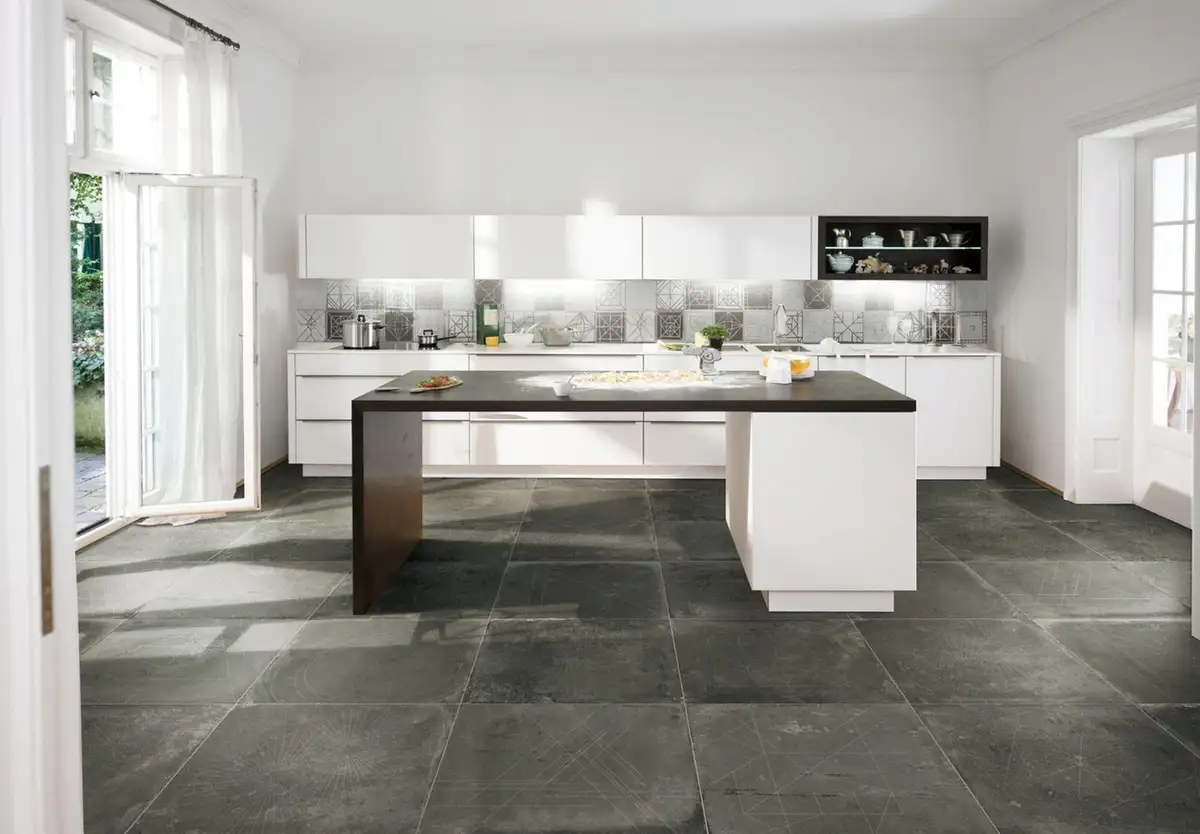
2. Natural Stone Tile (Marble, Travertine, Slate…)
There has been a surge in interest in natural stone flooring ideas for kitchens, particularly among ecotourists. Each with different colors, patterns, and textures; polished, matte, or brushed options, these 2025 trends kitchen flooring ideas add character to your kitchen.
What Makes It So Special?
- Natural stone kitchen and floor ideas, timeless beauty, and exceptional durability make it a product that will last for decades.
- An aesthetic feast, it adds a natural atmosphere to your kitchen.
- Increases the value of your home.
- Properly carries heat, making it ideal for use as an underfloor heating system.
What are the Challenges?
- It can be a bit hard on the wallet, it is an expensive option.
- Due to its porous structure, it is sensitive to stains and moisture and requires regular care.
- Soft stones like marble are prone to scratches.
- It is cold and hard (if there is no underfloor heating).
- You need a skilled craftsman to install it.
Small Note: Each piece is unique; each stone tells a different story.
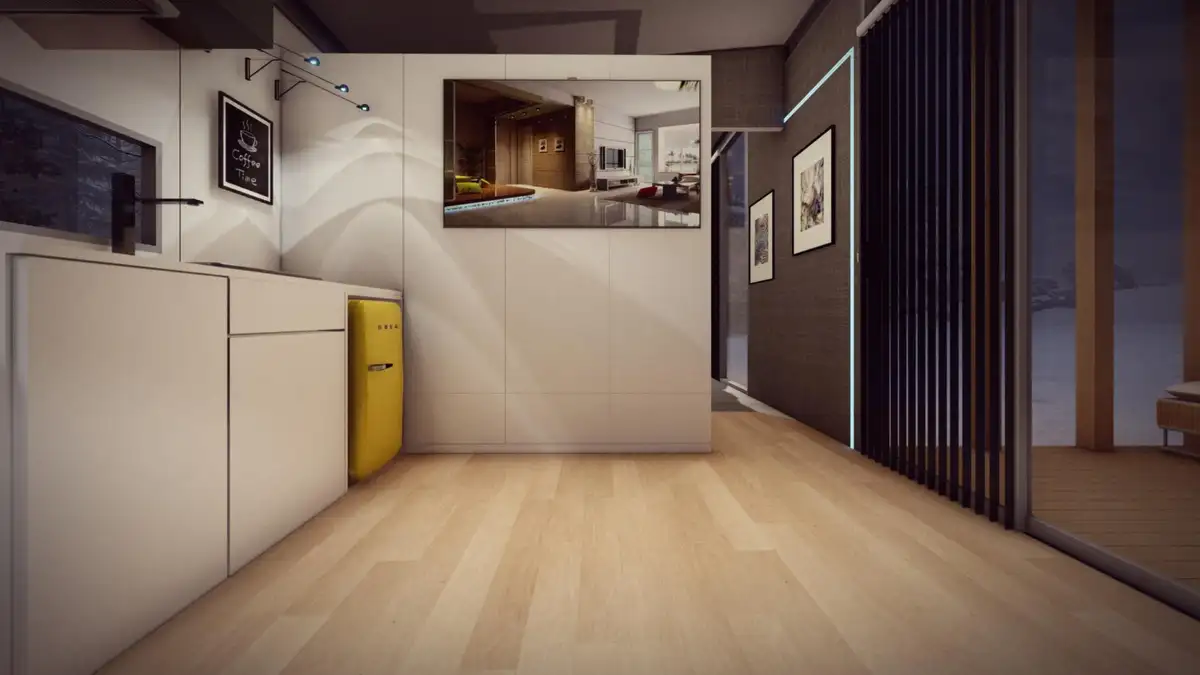
3. Engineered Wood Floor
The engineered wood floor is produced by veneering real wood on top of several layers of plywood or fiberboard. It offers the warmth of solid wood and is a more durable alternative for the kitchen.
What Makes It So Special?
- Engineered wood kitchen floor covering ideas are more resistant to changes in humidity and temperature than solid wood.
- The appearance is like solid wood, with elegance guaranteed.
- Installing some of these kinds is so simple that you can do it on your own by yourself.
- Compatible with underfloor heating systems.
What are the Challenges?
- If the veneer is too thin, you may not be able to sand it as easily as solid wood.
- The quality depends on the layers, cheap ones can wear out quickly.
- Excessive moisture can still give you a headache.
- It can be pricey for a superior option.
Small Note: There are floating, gluing, or nailing options; it is important to acclimatize before laying.

4. Luxury Vinyl Plank (LVP) / Luxury Vinyl Tile (LVT)
Made of PVC, these floors attract attention with their wood or stone-like patterns in 2025. With its layered structure, it is both durable and waterproof.
What Makes It So Special?
- Waterproof spills in the kitchen are no problem.
- It is a sturdy companion, resistant to scratches and stains.
- The material is soft and comfortable to stand for a long time.
- The price is generally affordable; it won’t break your budget.
- You can clean it up quite easily.
- You can even install it yourself with the click system.
What are the Challenges?
- Poor-quality ones tear easily.
- They are no substitute for natural materials.
- It does not add as much to the value of the house as stone or wood.
- It is not environmentally friendly because it is a synthetic material.
- It can be crushed under heavy objects.
Small Note: There are different thicknesses and layers of wear; be careful not to stick it on a damp floor.
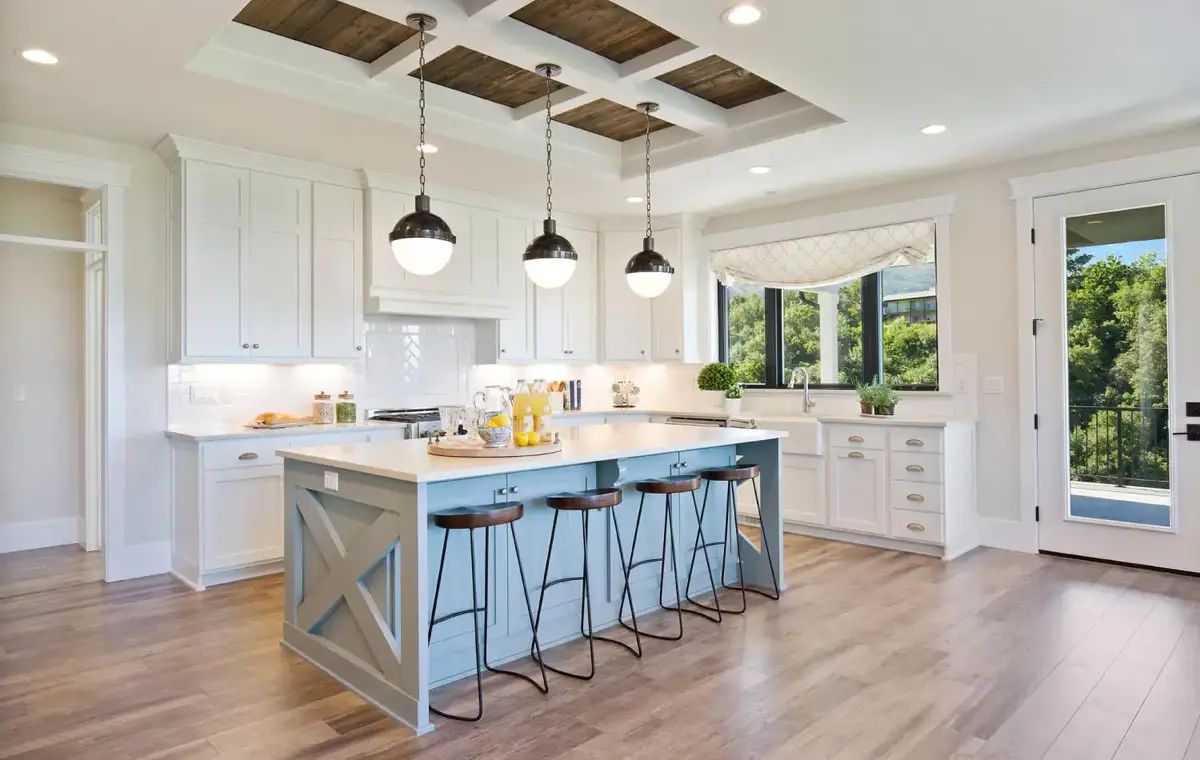
image source: angi.com
5. Laminated Parquet
The laminated parquet has a layered structure: a fiberboard core, a decorative surface, and a durable top layer. It looks like wood or stone, stylish and practical.
What Makes It So Special?
- Laminated small kitchen floor tile ideas are a pocket-friendly option.
- It is resistant to scratches and stains.
- No upkeep is required, simple to clean.
- The Click System makes it simple to install.
- There is plenty of variety in design.
What are the Challenges?
- It can swell if water seeps in, so it is not suitable for moisture.
- In the event of damage, it must be replaced as it cannot be sanded.
- Its synthetic structure is not environmentally friendly.
- Not completely watertight, but long-lasting still.
Small Note: There are water-resistant types, but the substrate is important.
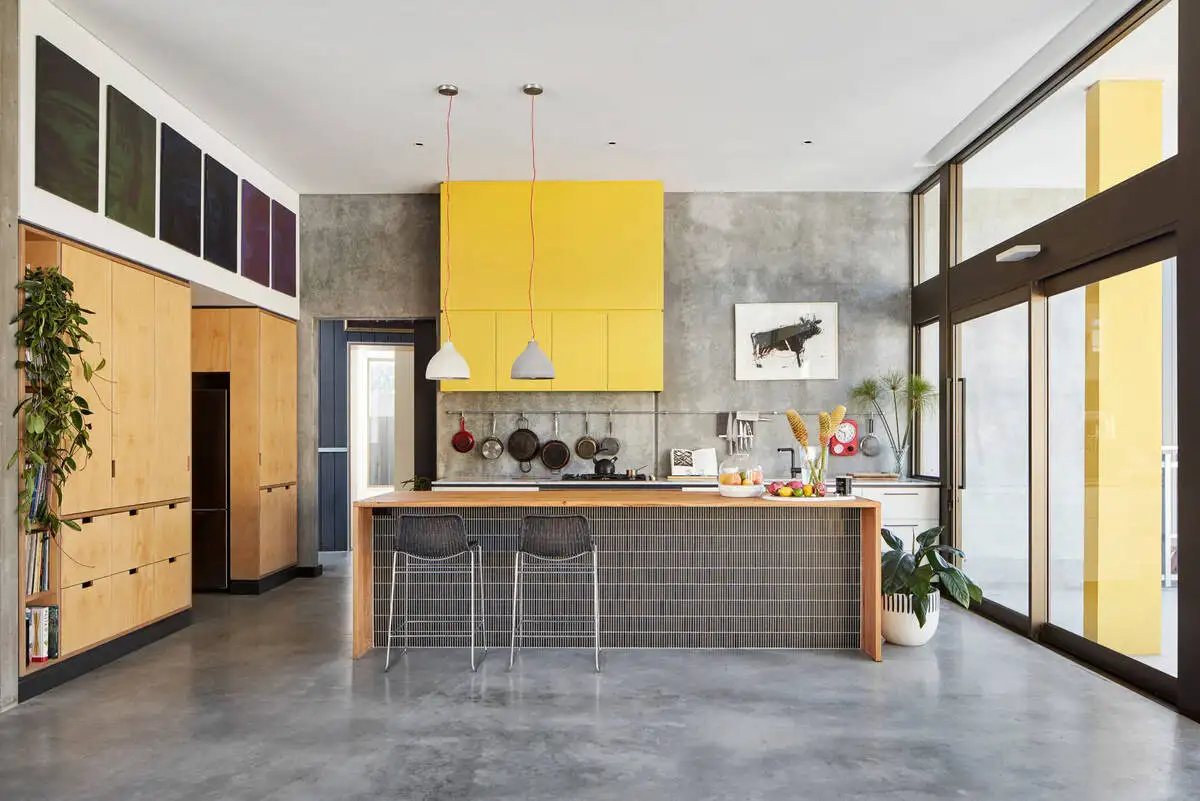
image source: houzz.com
6. Concrete Floor Coating
The concrete surface is shaped by polishing or texturing. It adds a minimalist and industrial feel to the kitchen.
What Makes It So Special?
- Concrete kitchen floor tiles ideas are exceptionally long-lasting, even in busy areas.
- Requires little upkeep; sweeping and wiping will do the trick.
- The product stores heat and is highly adaptable to underfloor heating systems.
- Resistant to flames and blows.
What are the Challenges?
- Standing on such a hard surface for long periods of time can be quite tiring.
- Without heating, it is cold.
- It is sensitive to moisture if it is not sealed.
- The industrial style is not for everyone.
- Upholstery is tricky.
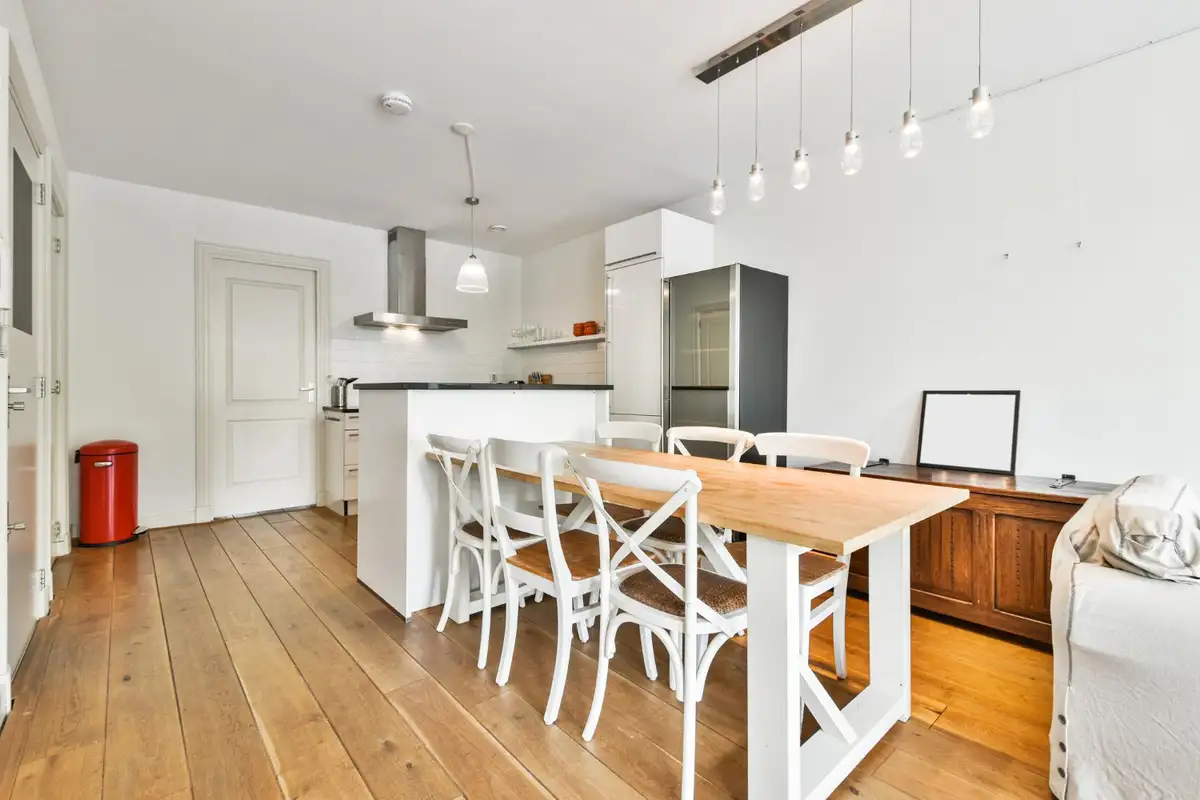
7. Solid Parquet
Made from a single piece of wood, this floor feels cozy with its natural patterns. Timbers like oak and walnut are among the many options available in the market in 2025.
What Makes It So Special?
- Solid parquet small kitchen floor plan ideas have a timeless beauty that adds warmth to your kitchen.
- Take good care of it, and it will last for generations.
- You can sand and polish it; it will always look new.
- It increases the value of the house.
- It is an environmentally friendly choice.
What are the Challenges?
- The product is sensitive to water and scratches.
- The system is difficult to maintain.
- Moisture is the main enemy in the kitchen.
- It’s an expensive option.
- Underfloor heating is not a suitable application for this.
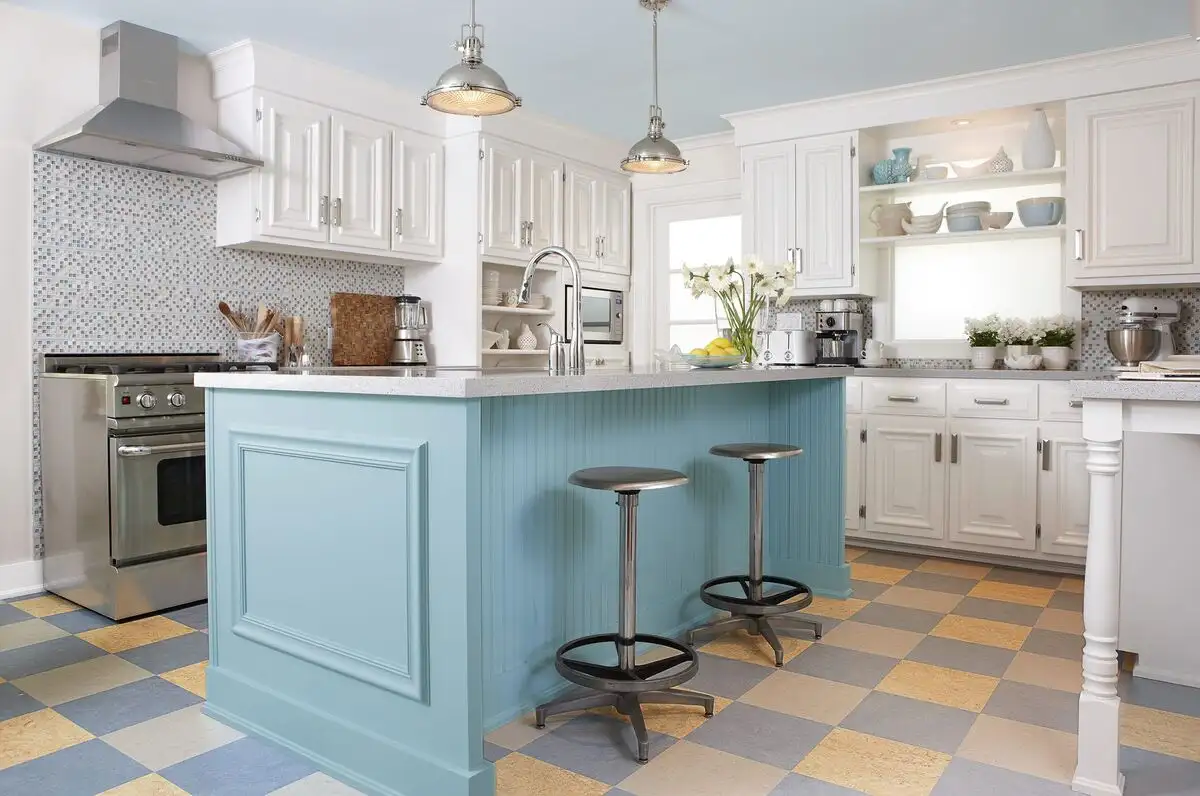
image source: thisoldhouse.com
8. Linoleum
Made from natural materials, linoleum is both durable and water-resistant. Color and pattern options are limited but ideal for those looking for simple elegance.
What Makes It So Special?
- It is a sustainable material, you have no doubts about it.
- It is durable and long-lasting.
- The material is strong against water.
- The material is easy to clean and provides a soft feel.
What are the Challenges?
- There is not much variety in design.
- It is not as common as vinyl; it can be hard to find.
- It may require a craftsman to install it.

image source: realhomes.com
9. Rubber Floor
In addition to being long-lasting and slip-resistant, rubber floor also provides comfort. Although we typically see it in commercial kitchens, it is equally effective when used at home.
What Makes It So Special?
- It is highly durable and resistant to traffic.
- The flooring is safe and non-slip.
- The surface is soft and comfortable to stand on.
- Water resistant.
- Easy to clean.
What are the Challenges?
- Limited choices in style.
- It has an industrial feel, but it may not appeal to everyone.
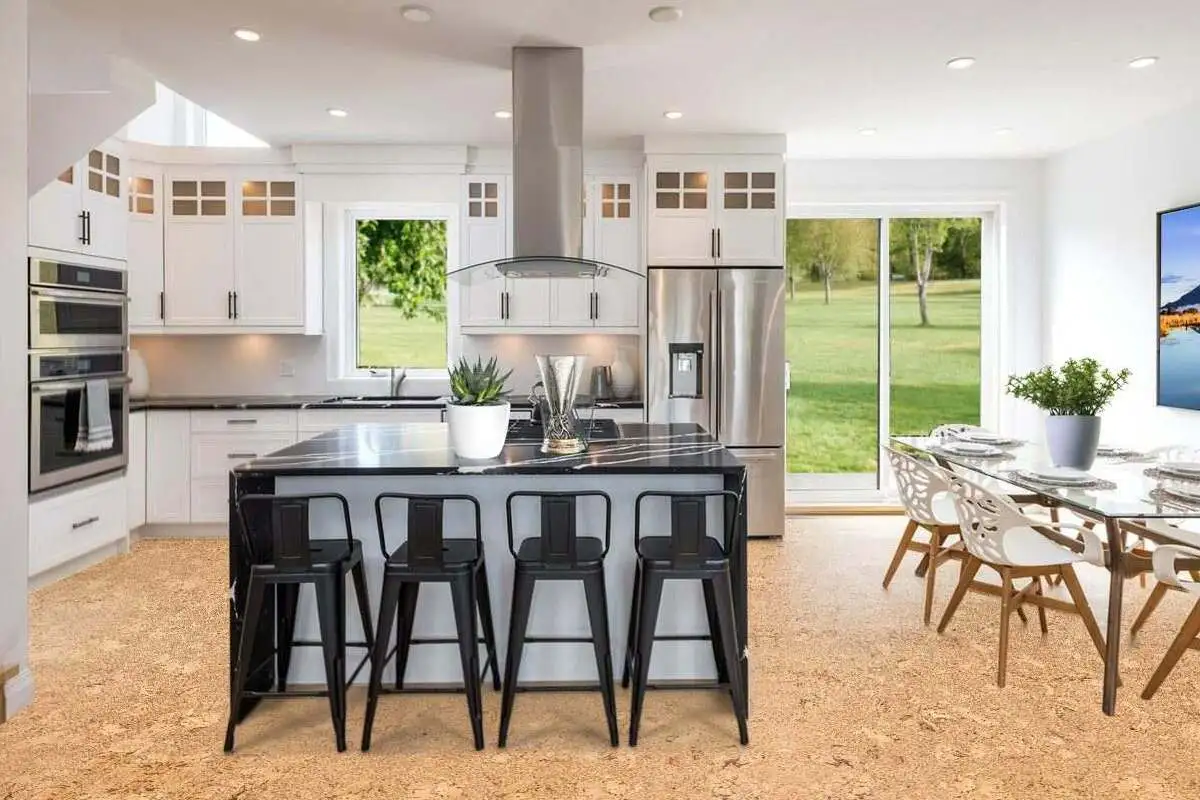
image source: pudioutlet.shop
10. Cork Floor
Derived from the cork oak tree’s bark, it is a natural, gentle, and eco-friendly substitute.
What Makes It So Special?
- It is an environmentally conscious choice.
- Softly pampers your feet.
- It provides sound and heat insulation.
- It has an antibacterial structure.
What are the Challenges?
- It is open to scratches, you need to use it carefully.
- Colors may fade over time.
- Placing can be challenging.
Small Note: If well sealed, it will also withstand water.

11. Wood Look Plank Tile
Ceramic or porcelain plank tiles designed to look like wood feature realistic patterns that mimic the look of real wood. Grayscale options, in particular, are trending high right now. These tiles combine the durability and water resistance of tile with the warm look of wood.
What Makes It So Special?
- Provides the look of wood, but with the water, fire, stain, and chip resistance of ceramic or porcelain.
- Ideal for humid and high-traffic areas such as kitchens.
- It offers options in different sizes, shapes, and patterns (wood, stone, marble).
- The design is integrated with matching mosaics and borders.
- Textured surface options are available for anti-slip, increasing safety.
- Easy to clean, low maintenance.
What are the Challenges?
- It can feel colder than real wood (this can be solved with underfloor heating).
- Its installation may require professional help, especially if it is oversized or has a complex pattern.
- It can be difficult to cut.
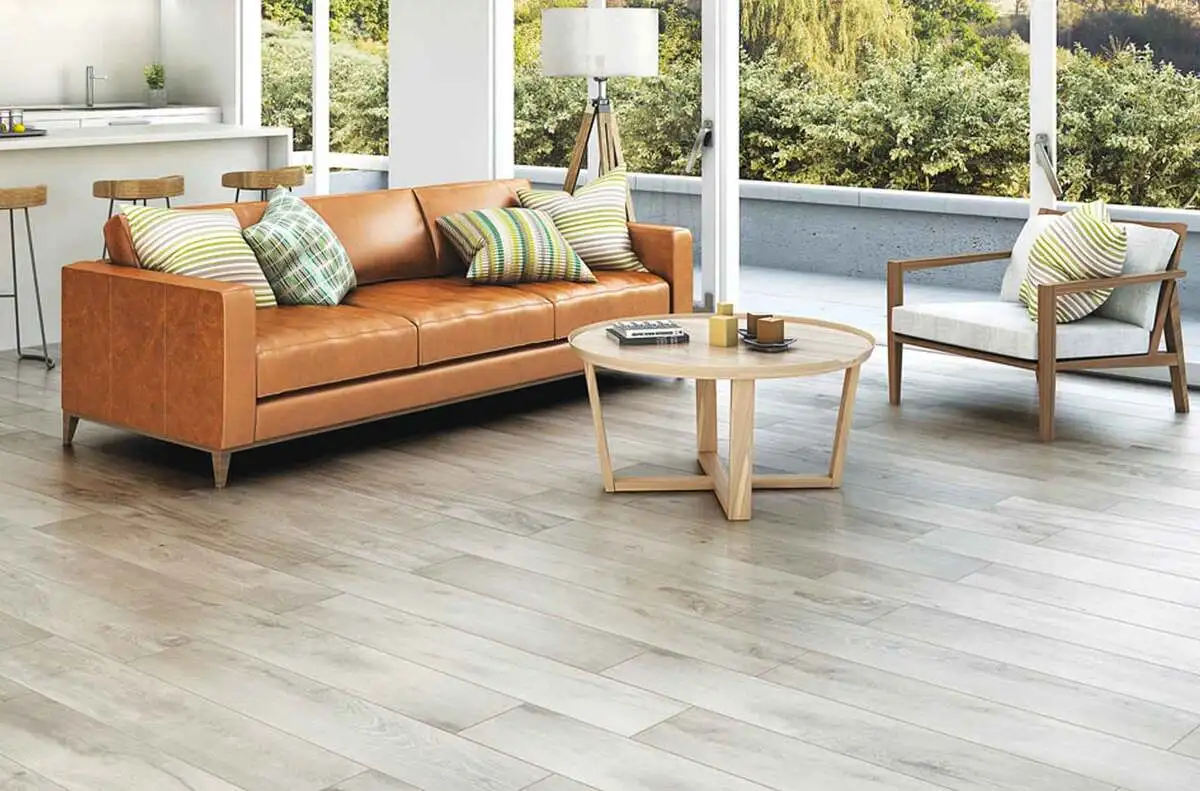
image source: flooringstorejacksonville.com
12. Wood Look Luxury Vinyl Plank (LVP)
Luxury vinyl plank (LVP) is a synthetic flooring material that offers the look of wood at an affordable price. This option, which has grown in popularity in recent years, is notable for its waterproof properties, especially for damp areas such as kitchens.
What Makes It So Special?
- It is waterproof and protects against spills in the kitchen.
- It offers a variety of patterns and textures that mimic the warm and aesthetic look of wood.
- Scratch-resistant and durable.
- It has a soft surface and feels comfortable underfoot.
- It is easy to clean and requires low maintenance.
- Easy to install with a click-and-lock system, you can even do it yourself.
- It is more affordable than real wood.
What are the Challenges?
- It is not environmentally friendly because it is made of synthetic material.
- Poor-quality options can easily tear or puncture.
- They can be crushed under heavy objects.
- It is not a complete substitute for real wood and does not increase in value as much as natural wood.
Conclusion:
Hopefully, you have found valuable information within these kitchen tile to wood floor transition ideas. If you need more, just drop us an email at USA Cabinet Store and take a look at our options.
Our team members are well-versed in the areas in which you require assistance and have years of relevant work experience. If you would like, our design team can tailor designs to your industry. We have nearly 15 years of expertise and can develop effective solutions to meet your specific needs.
Image Sources:
- angi.com
- houzz.com
- thisoldhouse.com
- realhomes.com
- pudioutlet.shop
- flooringstorejacksonville.com





